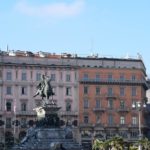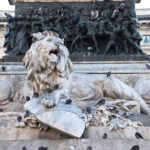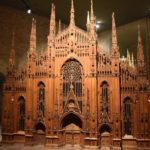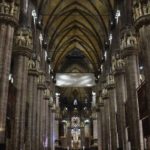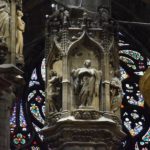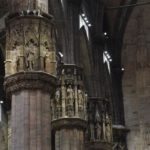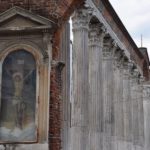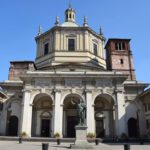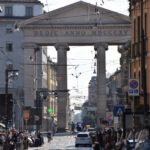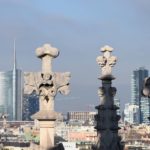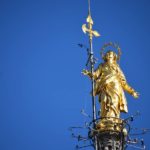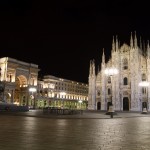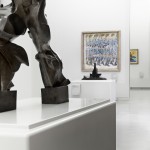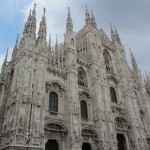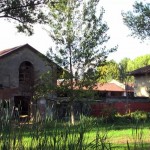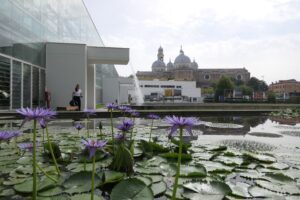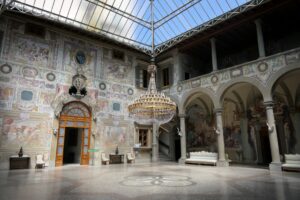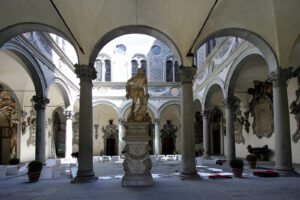Enjoy a night concert into the church (then go cycling with Critical Mass Milano!)
Milan: Duomo day, during ‘Christmas season’
A climb to the Duomo roof is a must!
My first winter journey to Milan was spent at the great 14th century Cattedrale di Milano! Using a Pass B, I visited the Duomo of Milan, the Duomo Museum, and climbed to the roof of this spectacular church. With what was left of the afternoon, I wandered the Saturday markets in the piazza. The Christmas season is lively and the Christmas market booths surrounded the cathedral offering food and all sorts of Christmas treats and gifts.
The cathedral offers a variety of differently priced passes that allow one access to the Duomo and other sites. Pass B is a 12€ ticket that offers all the same sites as the Pass A, but is 4€ cheaper because one must climb the stairs to the Duomo roof rather than ride the elevator. I like the climb and was glad to save the Euros. And FYI – there are public toilets near the ticket office of the Duomo. Access costs 1€ but in a modern country that has a confounding resistance to clothes dryers and public toilets paying for relief is worth the Euro to me!
- Piazza del Duomo – Monument to Vittorio Emanuele II
- Lion covered with pigeons
- Museum: Model of the Duomo, linden wood and Walnut
Milan’s Duomo took an astonishing 579 years to complete! The Duomo was begun in 1386 and not completed until 1965. The cathedral is dedicated to Santa Maria Nascente – Mary of the Nativity. The Duomo is the largest church in Italy and the third largest church in the world. Only St Peter’s Basilica of Vatican City and the Basilica of the National Shrine of Our Lady of Aparecida of Brazil are larger. The inside of the church is a museum of architecture and religious art offering decorated columns, stained glass, paintings, sculpture, and of course relics!
- Duomo di Milano – interior
- Duomo di Milano – interior
- Duomo di Milano – interior
The day I visited the Milan orchestra and chorus were practicing for the upcoming Christmas concert. The music and singing were amazing! The yearly concert sponsored by the city of Milan and the Veneranda Fabbrica del Duomo offers open-door free admission. The Veneranda Fabbrica del Duomo of Milan is the institution begun in 1387 by Gian Galeazzo Visconti (1351-1402) who was Duke of Milan from 1385-1395. The organization was then and is now charged with the complete design, construction, restoration, and conservation of this world renowned, signature monument. Every year to celebrate the history, artwork, and heritage of the Duomo the city of Milan and the Veneranda Fabbrica del Duomo host a holiday concert honoring the Catholic feast days. The concert is always free to all people – tourists and Italians!
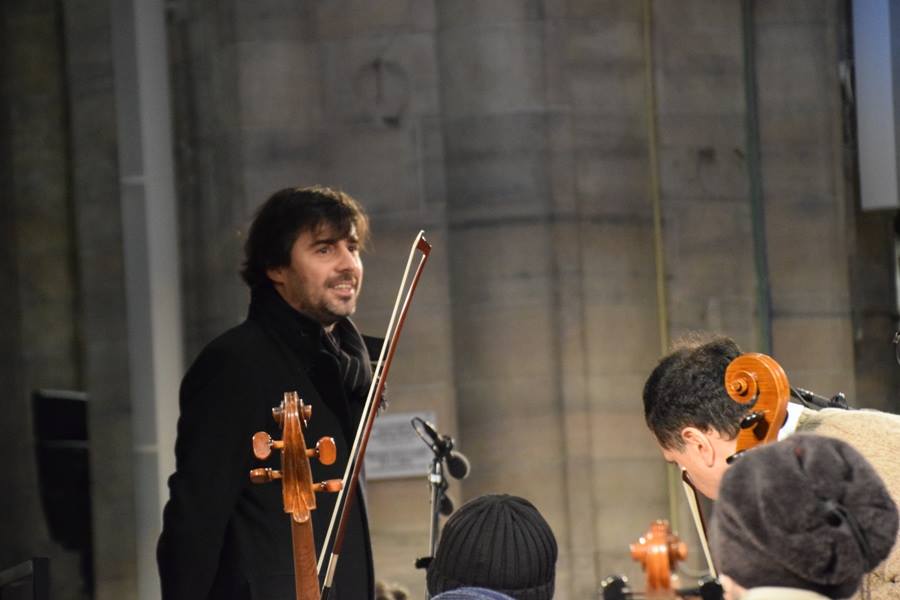
I Solisti Veneti – for the festive concert the orchestra, choir, and soloist will be conducted by Maestro Claudio Scimone born 1934 in Padua
The Duomo, also, is the epicenter of Milan and the streets of this city of 1.36 million people radiate out from the church and surround it in larger and larger concentric circles. This specific design is indicative of the location being the central site of the ancient Roman city – Mediolanum. This is the ancient name for Milan. The ancient city was actually founded by a Celtic ethnic group – the Insubres – who founded Mediolanum in 600 BC. About 400 years later the city was conquered by the Romans. For almost 700 years Mediolanum was steeped in the culture and polytheism of the Roman empire. That society violently resisted change and the influence of diversity seeking instead to require assimilation of all native and conquered peoples. The Edict of Milan signed by Constantine in 313 AD ended with a law of religious tolerance the gory martyrdom that gave present day Catholics and Christians the saints to whom many churches are dedicated.
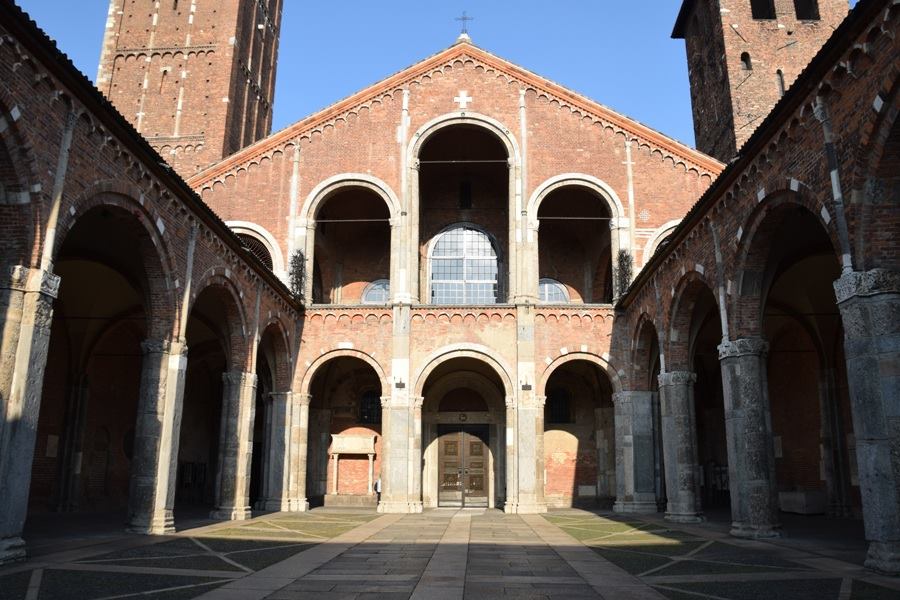
Basilica di Sant’Ambrogio (4th century)
There are remains of ancient Mediolanum in modern Milan. Outside of the fabulous 4th century Basilica di Sant’Ambrogio with its incredibly beautiful facade and quadriportico, my two favorite relics are the Colonne di San Lorenzo and the Egyptian red porphyry bathtub made for the emperor Maximian (250-310) who ruled Milan from 286-305. The Colonne di San Lorenzo are sixteen Corinthian columns outside the Basilica of San Lorenzo. They are thought to have been taken from a 2nd century pagan temple. The original basilica was constructed in the late 4th century and, also, is a remain from ancient Mediolanum. Both are located on the beautiful Corso di Porta Ticinese which is very near the Navigli – the canal system of Milan built between the 12th century and 19th century.
- Colonne di San Lorenzo
- Basilica di San Lorenzo. 4th century, current building completed in the 19th century
- Porta Ticense, constructed originally in the 16th century and rebuilt in 1802
The bathtub of Maximian is encased in a metal fence inside the Duomo and is used as a baptismal font. The Duomo Museum is astonishing. It is filled with sculptures – in wood, marble, terra cotta, gesso, and precious metals – and paintings, stained glass, tapestries, and holy vestments. The lights are low and the valuable artifacts are effectively illuminated so that one may take well composed photos – the personal mementos that I favor! All the pieces are in some way associated with the construction and reconstruction of the Duomo. Since this endeavor took place over the course of 579 years there is much to see!
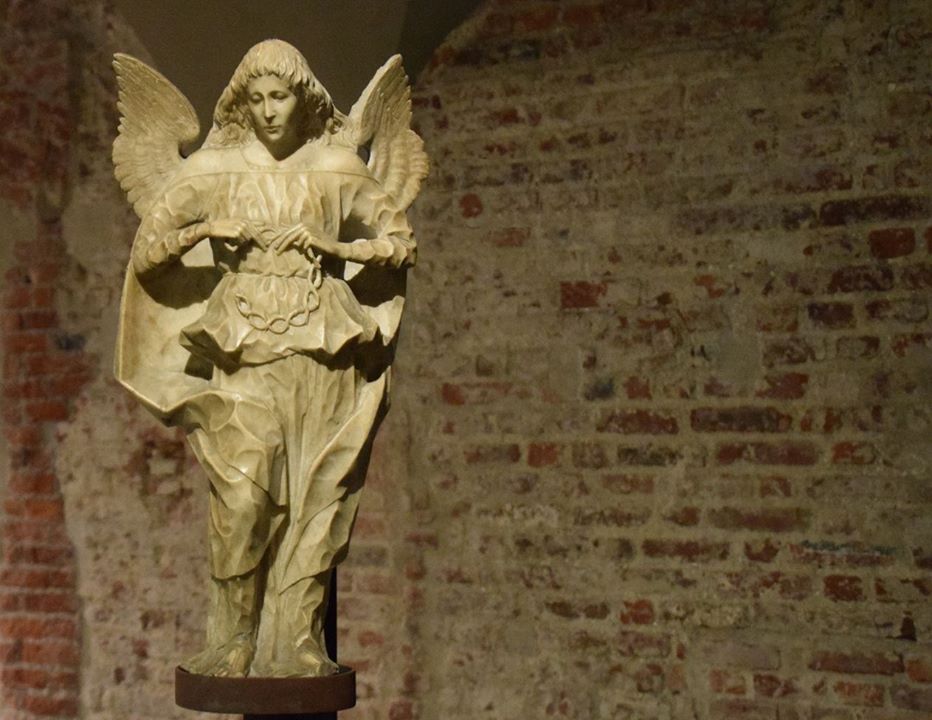
Marble angel holding a crown of thorns
When one finishes the tour of the Duomo Museum the 14th century church of St Gottard beckons! All one need do is step outside into the courtyard that attaches the small Chiesa to the museum. Chiesa di San Gottardo was built in 1336 for Azzone Visconti’s (1302 – 1339) ducal palace. It was built as a chapel for his court. Originally dedicated to Mary, it was later rededicated to San Gottardo the patron saint of a variety of illnesses – one of which was gout. Since Azzone Visconti suffered from gout, he likely appealed to the saint with his chapel dedication. Azzone Visconti is buried here. His coat of arms – seen above and beneath his tomb – was associated with the family from 1277-1395. It bears a striking resemblance to the coat of arms of the Sforza family. Because of their long tenure as governors of the city, the Visconti coat of arms became symbolic of the Duchy of Milan. When Bianca Maria Visconti (1425-1468) – the only heir to the Visconti dynasty and the Milan Duchy – married Francesco Sfroza (1401-1466) in 1441 the Sforza dynasty was begun. The Sforza incorporated the coat of arms of the house of Visconti containing the serpent with the traditional Sforza coat of arms containing the eagle. The families were merged and the Visconti “stemma” long associated with the Duchy of Milan joined serpent and eagle in the resulting dynasty now controlled by the Sforza’s.
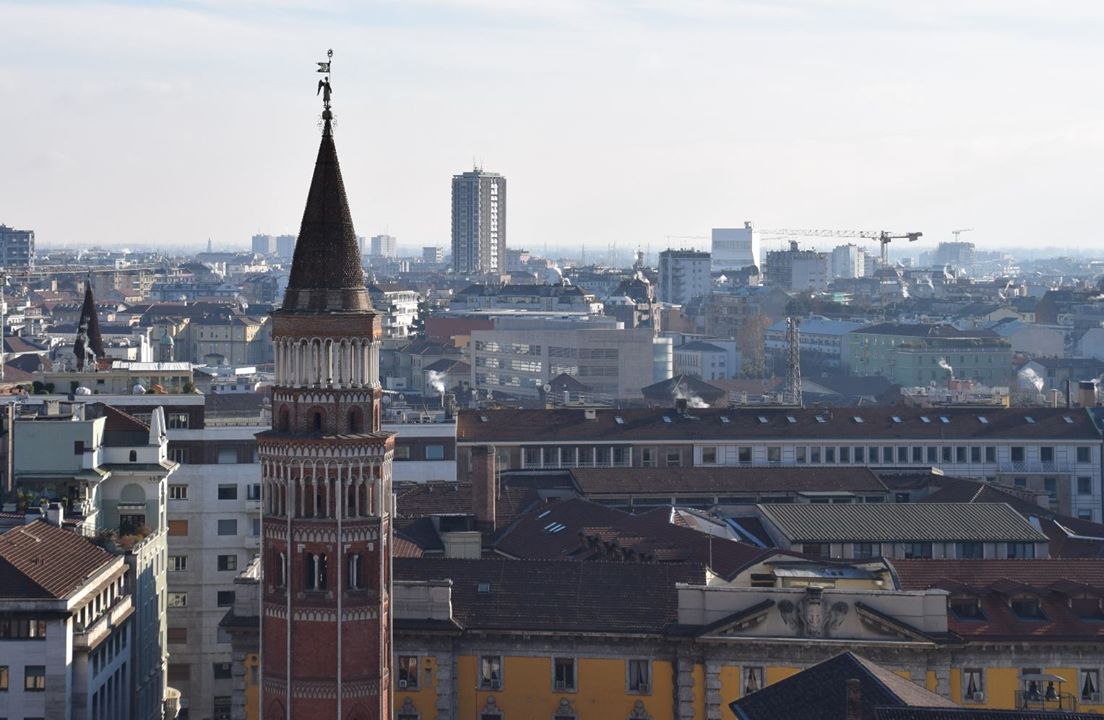
The steeple of the Chiesa di San Gottardo seen from the roof of the Duomo.
There is interesting history about the serpent imagery of the Visconti coat of arms. Some sources claim it to be a picture of the biblical Jonah being swallowed by a whale or sea serpent. Other historians claim that it represents a serpent swallowing a Sarceno (or Moor or Otttoman Turk). Still others insist it is a serpent giving birth to a baby. There, also, is a legend that it represents a snake found in the hat of Azzone Visconti, which did not bite him and, hence, was adopted as a symbol of his fitness to rule. Finally, there are those who say the image is that of a serpent swallowing a child who was rescued in time by an ancient member of the family displaying the pictograph. Interestingly, the serpent is always blue and the ‘biscione’ is non-venomous – a grass snake. As to the truth – you decide!
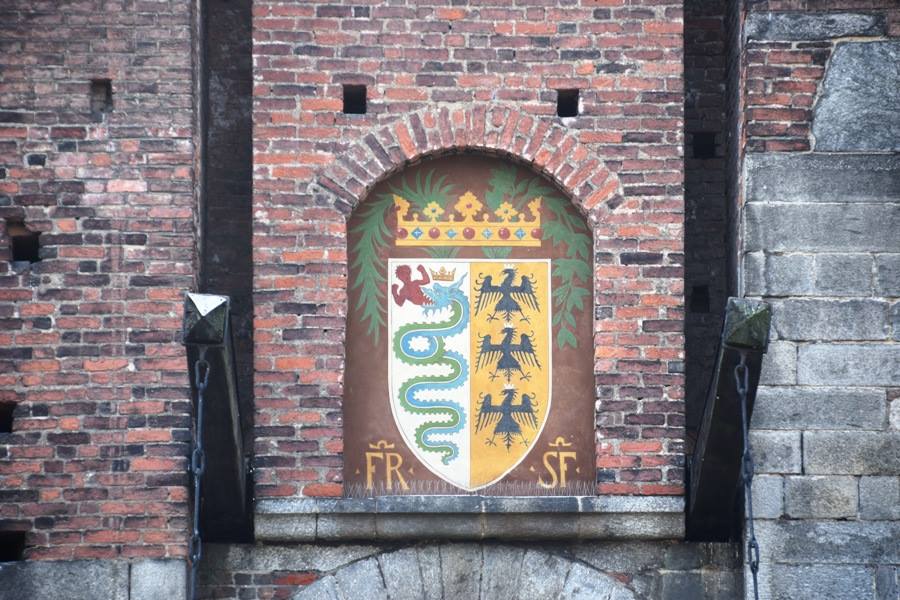
The Visconti-Sforza coat of arms as seen above the drawbridge of the Castello Sforzesco
Of all the things one does in Milan a climb to the Duomo roof is a must! During the height of the tourist season when the weather is warm the wait can be oppressive. Off season there are still plenty of tourists and locals but the wait can be a scant few minutes! Seeing an ancient Italian city from the top of whatever torre or roof is available to climb is overwhelmingly worth one’s increased heart rate. The views are always fascinating as the old city merges with and is overtaken by the new. Taking the stairs if that climb is available offers one a full appreciation of the gift that awaits at the top! The view from the Milan cathedral roof does not disappoint! The second floor terraces are not always open in winter because of ice and this day they did not open until after 1:00 pm. But, for certain, even a climb to the first floor terraces would be the perfect finish to a delightful tour!
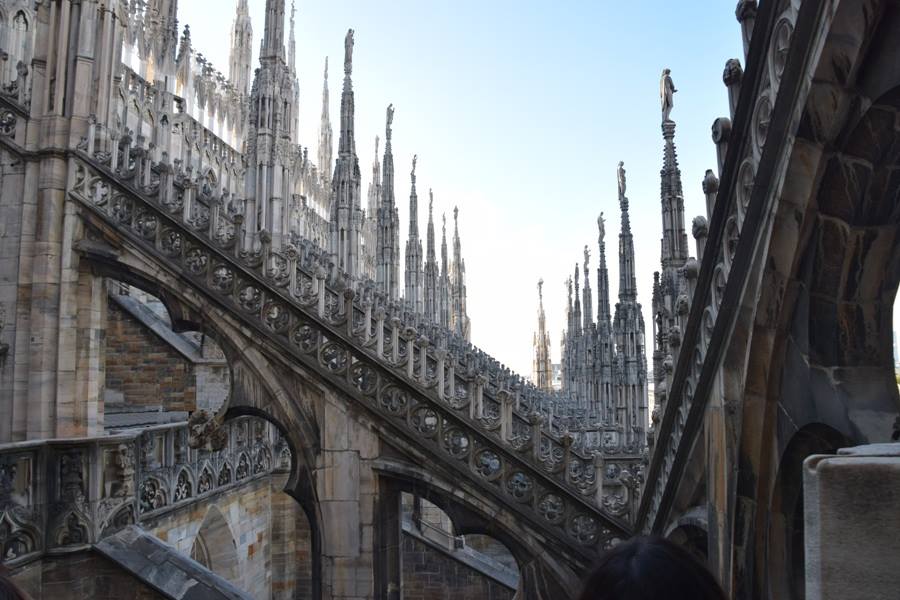
Duomo roof spires seen from the first terrace
Seen from the very top of the Duomo roof, the Torre Unicredit building with its pointy spire is impressive! The skyscraper is the tallest building in Italy. The 231 meter/758 foot tall structure was designed by the Argentine -American architect César Pelli. Pelli – now a respectable 91 years old – has been an award winning architect for decades. He is the designer of the Petronas Twin Towers of Kuala Lumpur, Malaysia. These were the tallest buildings in the world from 1998 to 2004. It seems fitting that he is responsible for the tallest building in all of Italy.
- The Unicredit building in Milan is the tallest building in Italy.
- Madonnina atop the main spire of the Duomo
- Me – on the roof!
This is the Madonnina of the Doumo di Milano as seen from the roof of the duomo. The Madonnina of the main spire is a sculpture by Guiseppe Perego and it was placed on the top spire of a relatively unembellished rooftop in 1774. Inside the Duomo is a scale model of the 18th century Madonnina made by the Fonderia Nolana del Giudice located in Nola in the province of Naples. They are both impressive statuary!
The Milan government of the 1930’s passed a law that says that no building can be higher than the Duomo Madonnina. To respect and abide this law, the owners of the skyscrapers of Milan often commission copies of the Madonnina to place atop their taller buildings. The Pirelli Skyscraper placed a copy of the Madonnina atop their building. When the Palazzo Lombardia was built and exceeded the height of the Pirelli building, they moved their Madonnina to the top of the palazzo. Even the tallest building in Italy – the Unicredit building – has plans to place a copy of the Madonnina atop its spire.
A day in Milan is a total delight. This December day was relatively warm – at least warm enough to melt the ice of the Duomo roof – and it was sunny and cheerful as the Christmas season always is. I hope you enjoyed this brief narrative of my Pass B tour!
Enjoy!
Buon Natale!
Virginia Louise Merlini
More pics on her Facebook profile!
Visit Milan: helpful hints
Italian name: Milano
Arrival
Milan has got three airports:
- Malpensa Airport is the largest international & intecontinental Airport in Northern Italy. 30 miles Northwest from the city centre. Connections:
→ Train Malpensa Express: trains leaves every 30 minutes in each direction, connecting the Airport to Milan Grand Central Station or Cadorna Railway Station. Terminals 1 and 2. It takes 45 min, price: 14 €
→ Shuttle Bus: Malpensa Shuttle and Malpensa Bus Express connect the airport to Milan Grand Central Railway Station and Milan’s Underground Network. Terminals 1 and 2. It takes 60/70 min, price: 8 € - City Airport Linate is an international airport connecting Milan with main European cities, located just 4 miles from the city centre. Connections by shuttle: Atm Bus n. 73 from Milano Duomo M1 – M3 (Piazza Diaz, direction: San Babila), first ride at 5.35 am, last one at 00.35. Frequency: every 10 min, price 1,5 €
- Milan Bergamo Airport Orio al Serio is mainly low cost flights Airport, located 30 miles Northwest from Milan. Connections only by Shuttle: There are 4 different bus companies, pricing changes from 5 up to 8 €
Transports
ATM is Milan public transport service both for bus, tram and subway. Single ticket costs 1.50€ for 90-min ride. Consider daily/weekly subscriptions. You can buy tickets also texting to 48444. Milan Subway is the longest in Italy, covering 95 km: Donwload and check the map.
Moving in town can be nice also by bike: Milan has got a powerfull bike sharing service providing both regular and e-bikes. Here is the experience of our Ambassador Kim Harding with BikeMi service and a useful video of our Ambassador Roxana explaining how does it work. Car Sharing is also good with many different companies to choose.
Try also the local urban railway train, called Passante Ferroviario, check the experience of our Ambassador Roxana Iacoban travelling by local train in town.
What to do in Milan
Milan is the Italian financial center and one of the European capitals of Fashion. Known for its nightlife as well.
Some tips on Italia Slow Tour: watch our web serie about Leonardo da Vinci’s places, climb on top of the Duomo, visit Prada Foundation, Museums and Art Galleries, taste some fine gelato and try the local Aperitivo and – not joking – enjoy a sailing trip (!!) or some time deep in the nature close to some actual farms and fields.
Where to sleep
Accomodations are quite expensive in Milan, fares rise up and hotels get full according to the rich event calendar of the city (see: Fashion Week, Salone del mobile, Big concerts, Theatre and Sport events, etc.). If you are not specifically interested in any of those, try to travel during other periods to save some money.
Italia Slow Tour recommends:
- Hotel Cervo in Garibaldi District if you want to stay close to city centre and enjoy the nightlife
- Hotel Concorde located on the Green Way Milan-Lecco to Lake Como, if you want to move around adn travel by bike
Shopping in Milan
The famous Fashion District involves the following streets/areas: Via Montenapoleone, via Manzoni, via della Spiga and Corso Venezia. The so called “Quadrilateral of Fashion”. Here you can find all kind of brands and shops. Easy to reach by Subway (stop at Montenapoleone station).
Don’t miss the Street Markets! Almost every day you can find one: best are the ones in Viale Papiniano (on Tuesday) and Via Fauchè (on Saturday). More on the official website of weekly street markets. If you are into sustainable local products, Milan has got 8 actual farms in town and a green Earth Market.
If you are interested in Outlet Shopping, in the outskirt of Milan you can find 4 different Fashion Outlets, in a radius of 62 miles. Here you can find everyday a lot of famous high quality Italian brands on sale, with prices cut off up to 50%. All the outlets are connected to the center of Milan by Shuttle Bus:
- Serravalle Designer Outlet – Shuttle departure from Milan Central Station or Cairoli square
- Fidenza Village Outlet Shopping – Shuttle departure from Piazza della Repubblica 5, at the corner with Turati st.
- Vicolungo The Style Outlets – Shuttle departure from Cairoli square
- Rodengo-Saiano Franciacorta Outlet Village – Shuttle departure from Cairoli square

